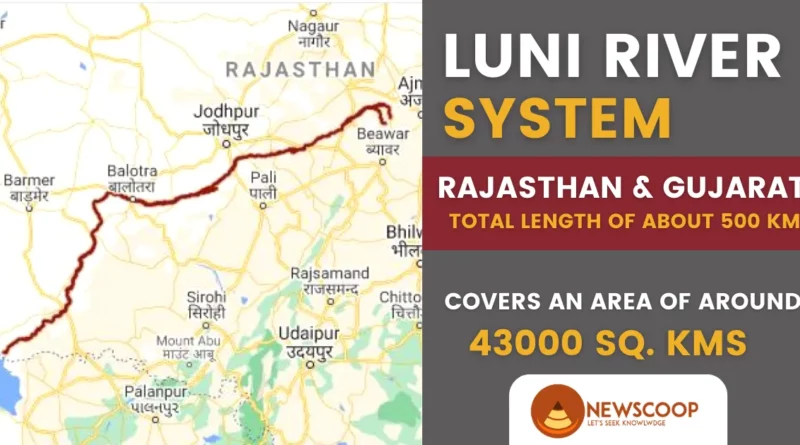Luni River: Left and Right Bank Tributaries | Dams, Map & Location | Origin & Mouth
The Luni River is a significant river in the western part of India, primarily located in the state of Rajasthan. It originates in the Aravalli Range near Ajmer and flows through the desert regions of Rajasthan and Gujarat before draining into the Arabian Sea. The river has a total length of about 500 km and a catchment area of approximately 43,000 km².
The Luni River is an important water source for the people living in the region, providing irrigation for agricultural lands and supporting livestock rearing. The river also has significant ecological, cultural, and historical importance. Many ancient civilizations such as the Indus Valley Civilization and the Harappan civilization developed along the banks of the Luni River.
The Luni River is a significant topic in the UPSC examination, especially for candidates appearing in the geography and environmental studies paper. The exam tests the candidates’ understanding of the geographical and hydrological features of the Luni River, its historical and cultural significance, and its ecological and environmental issues. Therefore, a comprehensive understanding of the Luni River and its importance is essential for aspirants preparing for the UPSC examination.
| Aspect | Information |
|---|---|
| Location | Western India, flows through Thar Desert in Rajasthan and Gujarat |
| Length | Approximately 500 km |
| Course | Westward through Rajasthan and Gujarat, passing through districts in both states |
| Drainage basin | Covers about 43,000 sq km in Rajasthan and Gujarat |
| Tributaries | Sukri, Jawai, Khari, Bandi, Sagi rivers |
| Water flow | Seasonal and highly variable, swells during monsoon |
| Water quality | Western India, flows through the Thar Desert in Rajasthan and Gujarat |
| Natural resources | Rich in salt, gypsum, and minerals |
Geographical Features of the Luni River
- Location: The Luni River is located in the western part of India, mainly flowing through the Thar Desert in the states of Rajasthan and Gujarat.
- Length: The Luni River is approximately 500 kilometers long, from its source in the Aravalli Range near Ajmer in Rajasthan to its mouth in the Arabian Sea.
- Course: The river flows westward through Rajasthan and Gujarat, passing through the districts of Ajmer, Nagaur, Pali, Jodhpur, Barmer, and Jalore in Rajasthan, and the districts of Kutch and Banaskantha in Gujarat. The river’s course is mainly through the Thar desert, which makes it a seasonal river and dry for most of the year.
- Drainage basin and catchment area: The Luni River has a drainage basin of about 43,000 square kilometers, covering parts of Rajasthan and Gujarat. The catchment area includes the Aravalli Range, the Rann of Kutch, and the Thar Desert.
- Tributaries: The Luni River has several small tributaries that join the main river during the monsoon season. The major tributaries of the Luni River are the Sukri, Jawai, Khari, Bandi, and Sagi rivers.
- Water flow: This is a seasonal river and has a highly variable flow depending on the monsoon rains. The river’s flow is almost negligible during the dry season, and the riverbed is mainly a series of shallow pools and sandbars. During the monsoon season, the river can swell to a considerable size and cause flooding in the surrounding areas.
- Water quality and pollution issues: The Luni River water quality has deteriorated over the years due to various human activities, including agricultural runoff, industrial pollution, and domestic sewage. The high level of salinity in the river water also limits its usability for agricultural purposes.
- Natural resources: The Luni River valley is rich in natural resources, including salt, gypsum, and minerals. These resources are extracted and used for various industries and purposes.
- Biodiversity: The surrounding areas are home to several species of flora and fauna, including several endangered species. The river supports several aquatic and semi-aquatic species, including various fish, crocodiles, and turtles. The surrounding desert regions also have a unique ecosystem, including several endemic species of plants and animals.
Left and Right Tributaries of Luni River
The Luni River has several left and right tributaries that join the main river during the monsoon season. Some of the major left and right tributaries of the Luni River are:
1. Left tributaries:
- Sukri River: The Sukri River originates in the Aravalli Range and joins the Luni River near Sujangarh in Rajasthan.
- Jawai River: The Jawai River originates in the Aravalli Range and joins near Sanderi in Rajasthan.
- Khari River: The Khari River originates in the Aravalli Range and joins near Jodhpur in Rajasthan.
- Bandi River: The Bandi River originates in the Aravalli Range and joins near Balotra in Rajasthan.
2. Right tributaries:
- Sagi River: The Sagi River originates in the Aravalli Range and joins the Luni River near Sirohi in Rajasthan.
- Masuda River: The Masuda River originates in the Aravalli Range and joins near Sanchore in Rajasthan.
- Morel River: The Morel River originates in the Aravalli Range and joins near Jalore in Rajasthan.
- Jojari River: The Jojari River originates in the Aravalli Range and joins near Jalor in Rajasthan.
These tributaries play a significant role in the Luni River’s hydrology and ecology, and their management is crucial for the sustainable management of the Luni River basin.
Dams on the Luni River
There are several dams and barrages constructed on the Luni River and its tributaries for irrigation, hydroelectric power generation, and water supply. Some of the major dams of the Luni River are:
- Bisalpur Dam: The Bisalpur Dam is located on the Banas River, a tributary of the Luni River, near Deoli-Banagher in Rajasthan. The dam has a storage capacity of 1,260 million cubic meters and supplies water for irrigation, drinking, and industrial purposes.
- Jawai Dam: The Jawai Dam is located on the Jawai River, near Sumerpur in Rajasthan. The dam has a storage capacity of 480 million cubic meters and provides water for irrigation, drinking, and industrial purposes.
- Taknet Dam: The Taknet Dam is located on the Taknet River, a tributary of the Luni River, near Sirohi in Rajasthan. The dam has a storage capacity of 90 million cubic meters and provides water for irrigation and drinking purposes.
- Dantiwada Dam: The Dantiwada Dam is located on the Sabarmati River, another tributary of the Luni River, near Dantiwada in Gujarat. The dam has a storage capacity of 3,226 million cubic meters and supplies water for irrigation, drinking, and industrial purposes.
These dams have played a significant role in enhancing the water availability and the socio-economic development of the Luni River basin. However, their construction and operation also have several environmental and social impacts, and their sustainable management and operation are crucial for the sustainable development of the region.
Historical & Cultural Significance of the Luni River
- Ancient civilizations: The Luni River valley is known to have been inhabited by several ancient civilizations, including the Indus Valley Civilization and the Harappan civilization. Archaeological excavations in the region have revealed several artifacts and remain from these ancient civilizations.
- Trade routes: Played an important role in the historical trade routes connecting the Indian subcontinent with the Middle East and Central Asia. The river’s strategic location made it an essential water source for traders and travelers crossing the desert regions.
- Religious significance: The River is considered sacred by many local communities, and several temples and shrines are located along the river banks. The river is also believed to have healing properties and is used for various religious rituals and ceremonies.
- Agricultural importance: The Luni River is a crucial water source for agriculture in the region. The river provides irrigation for the crops and supports livestock rearing in the surrounding areas.
- Traditional crafts: The Valley is famous for its traditional crafts, including pottery, weaving, and leatherwork. The river’s availability of clay, sand, and water has made it an ideal location for these traditional crafts to flourish.
- Folklore and legends: The River has inspired several folklore and legends in the local communities. These stories depict the river as a powerful and benevolent force that sustains life in the harsh desert regions.
- Tourist attractions: The River and its surrounding areas are popular tourist attractions, attracting visitors from around the world. The river’s scenic beauty, historical significance, and cultural diversity make it a must-visit destination for many travelers.
Conclusion
In conclusion, the Luni River is an important geographical, hydrological, historical, and cultural feature of western India. The river’s origin, course, and tributaries, along with its drainage basin and catchment area, make it a vital water source for agriculture, industry, and human settlements in the region.
The river’s historical and cultural significance, including its role in ancient civilizations, trade routes, and religious practices, adds to its importance. However, the river also faces several challenges, including water pollution, salinity, and degradation of natural resources, which require urgent attention and management. Overall, the Luni River represents a complex and interconnected system of human and natural factors, and its sustainable management and preservation are crucial for the well-being of both people and the environment.
Thank You!
Q: What is the length of the Luni River?
The Luni River stretches for approximately 500 kilometers from its source near Ajmer in Rajasthan to its mouth in the Arabian Sea.
Which states does the Luni River flow through?
The Luni River flows through the states of Rajasthan and Gujarat in western India. It courses through various districts in these states, including Ajmer, Nagaur, Pali, Jodhpur, Barmer, and Jalore in Rajasthan, as well as Kutch and Banaskantha in Gujarat.
Related Links:

